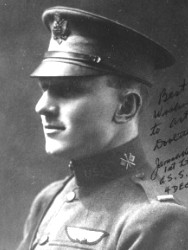James Alfred Keating
James Alfred Keating | |
|---|---|
 James Alfred Keating, 1918 | |
| Born | 4 December 1897 Chicago, Illinois, United States |
| Died | 2 October 1976 Fort Lauderdale, Florida, USA |
| Allegiance | |
| Service/ | Royal Air Force (United Kingdom) Air Service, United States Army |
| Years of service | 1917 - 1918 |
| Rank | Lieutenant |
| Unit | Royal Air Force |
| Battles/wars | |
| Awards | Distinguished Service Cross (US), Distinguished Flying Cross (UK) |
Lieutenant James Alfred Keating was a World War I flying ace credited with six aerial victories, including four triumphs during a running battle on 9 August 1918.[1]
Biography
Born in Chicago, Illinois, Keating joined the Air Service, United States Army, receiving his commission in December 1917. He was attached to the Royal Air Force in February 1918, being assigned to 49 Squadron flying DH-9 bombers in June. Along with his observer, 26-year-old Lieutenant Edward Arthur Simpson, Keating was designated as an American air ace, sharing five victories in two days. Their first victory was scored during a raid on Bethencourt when their formation was attacked by seven enemy aircraft over the target. The next day they scored four victories during a bombing raid on the bridge at Falvy.[2]
After the war, Keating returned to the United States. He died in October 1976
See also
References
- ^ "James Keating". theaerodrome.com.
- ^ Franks (1992) Over the Front: A Complete Record of the Fighter Aces and Units of the United States and French Air Services, 1914-1918 , Grub Street the Basement; First edition (May 1992), ISBN 0948817542
